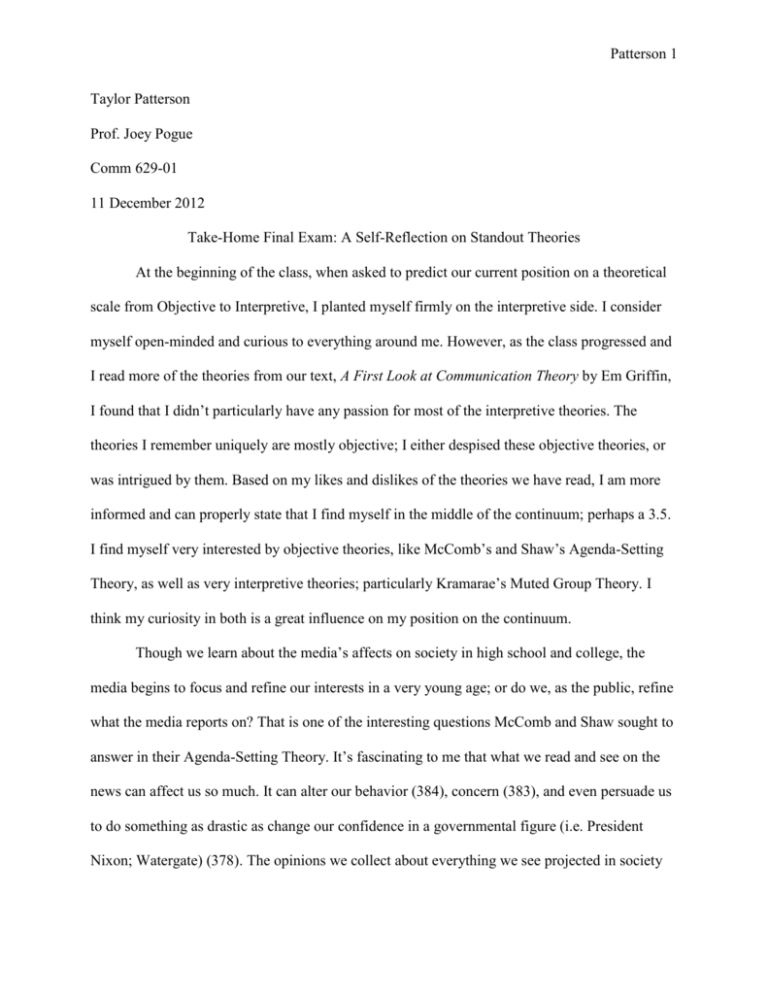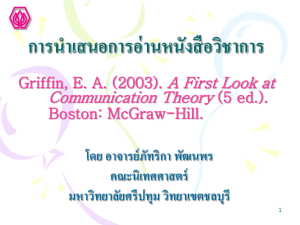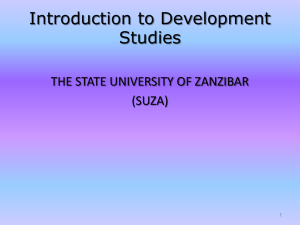Take-Home Final Exam - Taylor Patterson Elliott
advertisement

Patterson 1 Taylor Patterson Prof. Joey Pogue Comm 629-01 11 December 2012 Take-Home Final Exam: A Self-Reflection on Standout Theories At the beginning of the class, when asked to predict our current position on a theoretical scale from Objective to Interpretive, I planted myself firmly on the interpretive side. I consider myself open-minded and curious to everything around me. However, as the class progressed and I read more of the theories from our text, A First Look at Communication Theory by Em Griffin, I found that I didn’t particularly have any passion for most of the interpretive theories. The theories I remember uniquely are mostly objective; I either despised these objective theories, or was intrigued by them. Based on my likes and dislikes of the theories we have read, I am more informed and can properly state that I find myself in the middle of the continuum; perhaps a 3.5. I find myself very interested by objective theories, like McComb’s and Shaw’s Agenda-Setting Theory, as well as very interpretive theories; particularly Kramarae’s Muted Group Theory. I think my curiosity in both is a great influence on my position on the continuum. Though we learn about the media’s affects on society in high school and college, the media begins to focus and refine our interests in a very young age; or do we, as the public, refine what the media reports on? That is one of the interesting questions McComb and Shaw sought to answer in their Agenda-Setting Theory. It’s fascinating to me that what we read and see on the news can affect us so much. It can alter our behavior (384), concern (383), and even persuade us to do something as drastic as change our confidence in a governmental figure (i.e. President Nixon; Watergate) (378). The opinions we collect about everything we see projected in society Patterson 2 are gathered from our knowledge of the incident(s), but our knowledge is not really our own. Rather, we repeat what is told to us by people who are present at these incidents, regardless of the bias they have. The infamous example of that would be the Fox News vs. CNN debate (Fox News being perceived as withholding a Republican bias while CNN is infamous for their democratic bias). Both networks, however, reported similar stories on the New York Post’s December 5th, 2012 cover photo. The photo shows a man trapped on the NYC subway tracks an instant before his death (see page 6). I personally find it very insensitive and heartbreaking for the late man’s family, yet I wonder if my image is warped by the media’s reports on it. Critics of the photo include The LA Times, The New York Times, USA Today, and other major competitors in the news world. I recognize their bias; by proclaiming that the New York Post’s cover selection is “despicable” and “insensitive” (Macleod 1), these papers can persuade their readers to protest the New York Post, eliminating a competitor. But what if these heavy hitters of the news world commended the photo instead of condemning it? Would the public still feel outraged by its insensitivity, or applaud the paper’s bravery in edgy journalism? In this case, I hope that McComb’s and Shaw’s struggles prove to be that we cater to the media, and not the other way around. Because of the scientific research McCombs and Shaw performed, using newspaper consumers who were undecided voters in a local election (379), I appreciate the objective standpoint on this extremely elaborate idea because it provides some physical, abrupt results that would be hard to estimate otherwise. The Muted Group Theory, however, offers little scientific study, but still grips me. First, may I just point out how the beginning of this chapter speaks exclusively of Cheris Kramarae’s credentials as a scholar, which has been very rare in length throughout the rest of the chapters. This is off-putting to me because it’s as if to unnecessarily Patterson 3 explain to the readers, “Do not worry, this woman is qualified to proclaim this theory. She’s not just another crazy feminist. Try to take this seriously.” Just the introduction to the theory already adds to Kramarae’s theory. I do appreciate Griffin’s disclaimer on page 462, stating that because of his recognized gender, his presentation of Kramarae’s message will be slightly distorted and less intensified. It surprises me that this theory is classified on Griffin’s scale at the farthest right, toward the interpretive side because within the text is great evidence and physical proof that the English language is dominated by male-references. There are countless examples given in the text. The Feminist Dictionary excerpt provided (467) is an innovative idea, one that I really, really like. I applaud the idea of changing the norms with a physical text; and, as we read about in the aforementioned Agenda-Setting theory, media can have a profound effect on the public. The only personal critique I have on the chapter is that I would have liked further detail on our language contributing to sexual harassment and rape culture; not because I am confused or defiant against the observation, but because I think it’s both engaging and morally compromising. I consider myself a feminist, and I was previously aware of our language as a harmful message against women, but reading further into this chapter focused my view and will hopefully sharpen my tongue. What I like most about these theories is that they both affect everyone in the Englishspeaking language, with the Agenda-Setting theory effecting nearly everyone around the world. The Rhetorical and Socio-Cultural traditions (40) are each etched into each of these theories. Both language and media are forms of mass communication, shaping our western culture as well as the minds of its people. There are two items I find amusing with this observation; (1) the rhetorical and socio-cultural traditions are both centered on the territorial communications spectrum (47) in similarity with my own placement on the scale; and (2) the media of the Patterson 4 Agenda-Setting theory and the language of the feminist-cause as described in the Muted-Group theory are opposites on the theoretical spectrum but go hand-in-hand. Obviously, malepenetrated language is used throughout the common western media, while feminists are using media (i.e. the woman’s dictionary, the internet) to change the concepts of language. While they operate within each other, ultimately, the concepts are fighting against one another. These theories are relatable, and therefore easier for me to understand. Both theories are inviting to me and leave me wanting to read more on the subject. Like the aforementioned, these next two theories stand on opposite sides of the theoretical spectrum, but neither one intrigue me. I find Stella Ting-Toomey’s Face-Negotiation theory situational and a bit overbearing; whereas Marshall McLuhan’s Media Ecology theory comes across as bland and oddly cut-and-dry for an interpretive theory. Ting-Toomey’s Face-Negotiation theory focuses on the “face” (407), which is a concept I actually enjoy, however, Griffin explains that the projected image of ourselves changes by situation and is determined by certain factors. I am allured by the recognition of different cultures explained in the chapter, but it does not classify everyone’s reactions to certain situations. Throughout the chapter, there are equation-like actions to take in order to manage “the face” in certain situations; I don’t necessarily agree with that idea because it is difficult to imagine the ability to predict a generalized outcome from a situation. For example, when President Obama was re-elected, one could assume that all members of the Republican Party were down-trodden, but that was not necessarily the case. Even if it was, I doubt all Republicans are unhappy with the president for the exact same reason(s). Their motivation that stimulates their emotions will result is various different responses/actions. Patterson 5 Marshall McLuhan’s Media Ecology theory is a take on media differing from that of McComb and Shaw’s in a very curious way. I do not particularly like the humanization of media and its physical evolution being based on the inventions of its audience. The theory expresses that rather than the content of the media being noted, the medium is the message. I would say that the main reason I am indifferent to this theory is that I enjoy the Agenda-Setting theory as a definition of media influence more than than McLuhan’s. I am not trying to brush-by these theories, but it is difficult to justify my apathy about concepts that scholarly philosophers have spent years studying. I would not say either of these theories are genuinely incorrect, but I would say that the information is portrayed as pedantic. Rather than contradict the theories I find least compelling, perhaps I should perform further research. I believe further research is required for nearly every theory within out text. From reading and participating in class, I have come to find that there are two-types of theories; (1) theories that fascinate me, (2) and theories that will fascinate me. Human communication is so diverse, messy, and continually growing. With the internet/technology becoming the most common way to communicate, communication opens itself as a new frontier. The media has drastically adapted, and so it will be interesting to note the further developments on both the Agenda-Setting and Media Ecology theories. With that in mind, texting and instant messaginglingo is already a new language in itself, leaving Muted Group theorists a new territory to explore and use; and I wonder if Face-Negotiation tactics observations will alter with cyber mediated communication. All in all, I leave this semester having learned a lot about human communication, as well as myself. Both of which, I obtain an optimistic disposition. Patterson 6 *The caption at the bottom of the cover reads, “Ki Suk Han of Queen, hurled to the tracks, tries to climb to safety yesterday as a train bears down on him in Midtown. He was fatally struck seconds later.” Patterson 7 Works Cited Griffin, Em. A First Look at Communication Theory. 8th ed. Boston: McGraw-Hill, 2006. Print. Macleod, Dan. "A Picture of Controversy." New York Post. N.p., 5 Dec. 2012. Web. 9 Dec. 2012.







